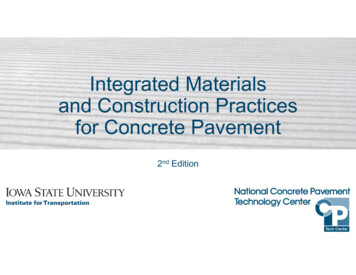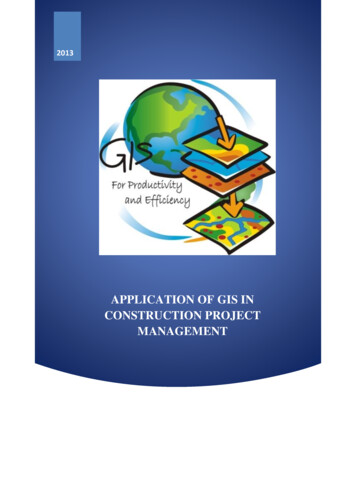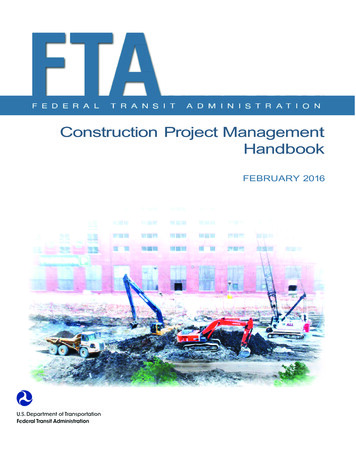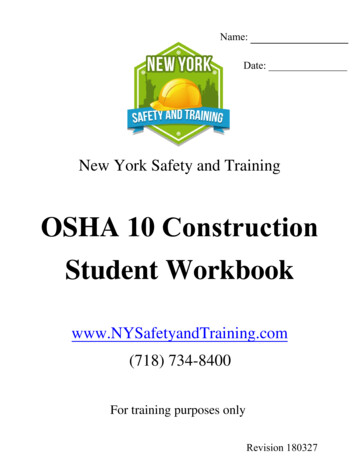
Transcription
Integrated Materialsand Construction Practicesfor Concrete Pavement2nd Edition
PurposeA resource to: Bridge the gap between research and practice Encourage good practices Provide practitioners with tools to design, build, and maintain concretepavements Help practitioners improve communication between practice s &QualityMixture2
Learning objectives Understand concrete pavements as integrated systems Appreciate that constructing a concrete pavement project is a processinvolving interrelated practices Implement technologies to optimize performance Recognize and avoid factors leading to premature distress Access how-to and troubleshooting information3
AudienceAnyone interested in optimizing concrete performance Engineers Quality control (QC) personnel Specifiers Contractors Materials and equipment suppliers Technicians Construction supervisors Tradespeople4
What’s NewThis edition is an update: Sustainability MEPDG PEM RTSAuthors Peter Taylor Tom Van Dam Larry Sutter Gary FickReview by TAC Previous authors5
Overview 10 Chapters Sustainability Design Materials and Mixtures Construction Quality Troubleshooting6
ContentsChapter 2 Basics of Concrete Pavement Sustainability What is Pavement Sustainability? Concrete Pavement Design Materials Construction7
What is Sustainability?A sustainable pavement is one that achieves its specificengineering goals, while: It meets basic human needs Uses resources effectively Preserves/ restores surrounding ecosystemsCostPeople8EnvironmentMuench and Van Dam
Strategies for Design Longevity Reduced user impact Durable mixtures Increased Thickness CRCP for heavy traffic Local and Recycled Materials Use less fuel to haul it in Avoid throwing awaythe old pavement9
Sustainability and Materials Recycled, Coproduct, and Waste Materials Cementitious Materials and Concrete Mixtures Portland Cement Supplementary Cementitious Materials Blended Cements Aggregate Materials Concrete Mixture Proportioning and Production Other Concrete Mixtures and Emerging Technologies10
What About Operations? At least 80% of the energy and emissions associated withpavements is incurred during use Fuel efficiency Traffic flow Rolling resistance Albedo Heat island Lighting costs Noise11
Which is more “sustainable”?12
ContentsChapter 3 Basics of Concrete Pavement Design Integrated Pavement Design Pavement Types What Do We Want? What Factors Do We Have to Accommodate? Getting What We Want Constructability Issues Concrete Overlays13
It’s Not Just ThicknessJointed Plain14
It’s Not Just ThicknessContinuously reinforced15
What Do We Want? Service life Structural models assume that materials will not fail How long should it last? Performance: Structural Functional16
What Do We Want? Structural – is it broken?17
What Do We Want? Functional – do I want to drive on it?18
ContentsChapter 4 Fundamentals of Materials Used for Concrete Pavements Cementitious Materials Aggregates Water Chemical Admixtures Dowel Bars, Tiebars, and Reinforcement Curing Compounds References19
What do we have to work with20
Aggregates Aggregates comprise 70% of the volume of a concrete mix. Aggregate properties can have an influence on concreteproperties: Durability Workability Strength Dimensional changes21
Cementitious MaterialsHydraulic cement – reacts with water, creates CHPortlandCementSlagCementClass CFly AshClass FFly AshSilicaFumePozzolan – reacts with cement and water, consumes CHNot to scale22
Cement is Changing23
Supplementary Cementitious Materials Fly ash Slag Natural pozzolan Silica fume“We deal with thenegatives to get apositive”24
Effects of Extra Water on Concrete Increases workability Lowers strength Increases drying shrinkage Increases permeability and reducesdurability25
Chemical Admixtures Air entraining admixtures (AEA) Water reducers Set modifying admixturesDon’t use to fix a bad mixture,use to Enhance!26
Contents Chapter 5 Hydration Stages of Hydration: Overview Portland Cement Supplementary Cementitious Materials Impact of Hydration Stages of Hydration: Details27
Five Stages of ification
Effects of SCMs Delayed final set. Reduced heat peak. Extended heat generation. Increased long-term strength. Reduced permeability.29
Contents Chapter 6 Critical Properties of Concrete Introduction Fresh Properties Mechanical Properties Durability Related Properties30
Fresh Properties Uniformity Workability Segregation Bleeding Setting Temperature effects31
Mechanical Properties Strength Stiffness Shrinkage Polishing Cracking32
Early-Age Cracking Factors Concrete moves (temperature and moisture gradients) Movement Restraint Load Loads Stiffness Stress Stress Strength Cracks33
Early Age CrackingDiscuss34
Early Age CrackingDiscuss35
Durability PropertiesAbility of the concrete to survive the environment to which it isexposed: Transport Cold weather Sulfates AAR36
TransportThe ease with which fluids can penetrate concrete Significance All durability damage is governed by permeability Factors w/cm SCM type and dose Hydration Cracking37
Cold WeatherTwo mechanisms: Saturated freeze thaw Oxychloride formation38
Alkali-Silica Reaction Water alkali hydroxide reactive silicate aggregate alkalisilicates Alkali silicates water gel expansion Silicates from aggregates Alkalis from cement (Na and K)39
D-Cracking Certain calcareous aggregates absorb water Pore size prevents water leaving the system Freezing causes damage40
Contents Chapter 7 Mixture Design and Proportioning Introduction Sequence of Development Aggregate Grading Optimization Calculating Mixture Proportions Adjusting Properties“The beast of interesting proportions”41
Design Choosing what you need Workability, setting time Durability, strength,cracking risk42
Proportioning43
How do we proportion to achieve design goals?Aggregate System Type, ShrinkageAggregatestability ‐‐‐‐ Paste qualityAir, w/cm, SCMtype and dose Paste quantityVp/Vv ‐‐‐ ‐
Step 1 Paste Quality Binder type Cement type SCM type and dosage w/cm 0.38-0.42 Air void system 0.2 SAM 0.008 in. spacing factor 5% in place Stable45
Step 2 Aggregate system Tarantula Curve46
Step 3 Paste ContentPaste should be approximately 1.5x - 2x of voids47
Contents Chapter 8 Construction Subgrades Bases Concrete PavingSupport system should bestable and uniform with decentdrainage48
Contents Chapter 9 Quality and Testing Quality Assurance Monitoring the Mixture Monitoring ConstructionActivities Test Methods“Delivering what is expected”49
Defining Quality Simple Definition (Philip Crosby) Quality: “Conformance to requirements” Quality is defined by our customers QA “Making sure the quality of a product is what it should be”50
Why Should I Care Money! Penalties vs IncentivesCONTRACTOR51
Why Should I Care Better working environment Project partners are qualified Contractor knows how the Agency will accept/pay for theproduct QC Plans remove some of the daily stress Product you paid forOWNER52
Trick Question How do the following people affect quality? Designer/Specifier Agency Inspector QC Technician Loader Operator at the concrete plant Truck Driver Paver Operator Concrete Finisher Texture/Cure Machine Operator53
Core Elements of an Agency QA ProgramQuality AssuranceQualityControl54AgencyAcceptance
LonglastingpavementAcceptanceQCQC data should be invisible to theAcceptance process55Construction ActivitiesThe Goal
How Do We Evaluate the Mixture? Measure everything duringprequalification Constructible (Workable) Dimensionally stable Aggregates Shrinkage Impermeable (Transport properties) Cold weather resistant Freeze thaw Salt attack Strong (enough)ConcretepropertyWorkabilityTest methodAggregate gradationCombined gradationASTM C 136 /AASHTO T 27ASTM C 566 /AASHTOT 255Tarantula curvePaste contentBatch sheetVKelly or BoxTP129 / PP84 X2Slump at 0, 5,10,15,20, 25, & 30 minutesASTM C 143 /AASHTO T 119SegregationAir void systemFoam drainage-Air contentASTM C 231 /AASHTO T 152, T196AASHTO TP118Retemper a sample anduse optical microscopyto assess clusteringASTM C 457Vibrate a container (airpot) for 5 minutes.Measure depth of mortarat the top surfaceASTM C 138 /AASHTO T 121SAMClusteringHardened airMortar contentUnit weightUnit weightStrengthdevelopmentCompressive orflexural strengthMaturityTransportResistivity / F factorSorptionOther56Test descriptionASTM C 39 / AASHTOT 22 and/or ASTM C 78/ AASHTO T 97 at 1, 3,7, 28 & 56 daysASTM C 1074Soak /store samples insalt solutionASTM C yComments Use the individual gradations andproportions to calculate thecombined gradation. Adjust combined gradation toachieve optimum workability Adjust paste content to findminimum paste needed while stillworkable Confirm that total is belowmaximum permitted for shrinkage Confirm that the mixture respondswell to vibration Look for excessive slump loss dueto incompatibilities. This is morelikely at elevated temperatures. Determine approximate WRAdosage Look for signs of segregation in theslump samples Assess stability of the air voidsystem for the cementitious /admixture combination proposed Determine approximate AEAdosage 0.2 target Can affect strength, Air content can also jump withretempering Calibrate SAM limits Provides information on the coarseaggregate content – maximum is ¼” Indicates yield the mixture and arough estimate of air content Establish basis for QC monitoring Calibrate strength gain for earlyage QC Calibrate flexural with compressivestrengths Calibrate the mixture so maturitycan be used in the field todetermine opening times Determine development of FFactor over time Determine time to criticalsaturation Calibrate microwave test withbatch data Determine hydration rates ofmixture.
Quality Control QC should include Unit weight Calorimetry Maturity Strength development Air void stability And a response Risk management571. Get lab mix accepted2. Ensure we are getting that mix
Contents Chapter 10 Troubleshooting and Prevention Overview Before the Concrete Has Set After the Concrete Has Set In the First Days after Placing Some Time after Construction58
IMCP 2nd Edition Format Interactive pdf available to download Limited printed copies Dreaming of hotlinking with other publicationswww.cptechcenter.org59
Understand concrete pavements as integrated systems Appreciate that constructing a concrete pavement project is a process involving interrelated practices Implement technologies to optimize performance Recognize and avoid factors leading to premature










